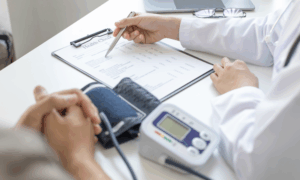| STT (No) |
DETAILED LIST OF GENERAL CHECKUP PACKAGES (Detailed General Health Check-up Package) |
|
|||||
|---|---|---|---|---|---|---|---|
| A. NURSING SECTION | |||||||
| 1 | Weight, Height, Body mass index | X | X | ||||
| 2 | Vital signs: pulse, blood pressure, temperature, respiratory rate | X | X | ||||
| 3 | Eye: vision check | X | X | ||||
| B. CLINICAL EXAMINATION | |||||||
| 4 | Comprehensive examination with a general internal medicine specialist: ask about medical history, medical history, clinical examination, consult on test results, prescribe treatment, consult on vaccination, plan health monitoring by a general internal medicine specialist, USMLE Step 3 certification direct examination. (General Internal Medicine Consultation: Thorough medical assessment including history taking, physical examination, test result review, immunization consulting and treatment — performed by an Internal Medicine specialist with USMLE Step 3 (US) certification.) | X | X | ||||
| 5 | Ear, nose, and throat specialist examination: Examination and consultation of ENT issues by an ENT specialist (ENT check: examine and consult ENT issues with an ENT Specialist) | X | X | ||||
| 6 | Gynecological examination: Breast examination and consultation on breast diseases; examination and consultation on common gynecological problems (Gynecology examination: perform manual breast examination and consult breast issues, consult common gynecological issues) | X | |||||
| C. BLOOD TEST SECTION | |||||||
| 7 | Full blood count: reviews of infection, anemia, platelet count-related disorder, leukemia, etc. | X | X | ||||
| 8 | hs-CRP (High-Sensitivity C-Reactive Protein): a highly sensitive blood test that detects low-grade chronic inflammation even when cholesterol levels are normal, used to assess the risk of cardiovascular disease | X | X | ||||
| 9 | Fasting glucose: diabetes screening | X | X | ||||
| 10 | HbA1C: Helps diagnose diabetes or prediabetes (HbA1c (Glycated Hemoglobin): helps diagnose diabetes mellitus and prediabetes) | X | X | ||||
| 11 | ApoB/ApoA1 Ratio: This is a measure of cardiovascular risk, reflecting the balance between atherosclerotic and anti-atherosclerotic particles in the blood. An increased ratio indicates a higher risk of heart attack or stroke, due to an increase in atherogenic (apoB-rich) particles or a decrease in protective (apoA1-rich) particles. This is considered a better predictor of cardiovascular disease than other common measures such as the total cholesterol/HDL-C ratio. | X | X | ||||
| 12 | Cholesterol total: helps evaluate the risk of atherosclerosis, cardiovascular risk (Cholesterol total: evaluate the risk of atherosclerosis) | X | X | ||||
| 13 | Triglyceride blood fat: helps evaluate the risk of atherosclerosis, cardiovascular risk (Triglyceride: evaluate the risk of atherosclerosis) | X | X | ||||
| 14 | LDL-c blood lipids: help assess the risk of atherosclerosis, cardiovascular risk (LDL-c: evaluate the risk of atherosclerosis) | X | X | ||||
| 15 | HDL-c blood lipids: help assess the risk of atherosclerosis, cardiovascular risk (HDL-c: evaluate the risk of atherosclerosis) | X | X | ||||
| 16 | Kidney function: evaluate the risk of kidney dysfunction | X | X | ||||
| 17 | Blood Urea Nitrogen: an additional test to assess kidney function by measuring the amount of urea nitrogen in the blood. | X | X | ||||
| 18 | Liver enzymes: investigate different causes of liver injury | X | X | ||||
| 19 | Liver enzymes: investigate different causes of liver injury | X | X | ||||
| 20 | GGT: investigates liver cell damage due to various causes (Liver enzymes: investigate different causes of liver injury) | X | X | ||||
| 21 | Total Bilirubin: A component of the comprehensive liver function test used to assess overall liver health. | X | X | ||||
| 22 | Direct bilirubin: Helps detect and monitor the progression of other liver diseases such as hepatitis, cirrhosis, gallstones, and cholangitis. | X | X | ||||
| 23 | Indirect Bilirubin: Used to screen for blood-related disorders such as hereditary anemia and hemolytic anemia. | X | X | ||||
| 24 | Alkaline Phosphatase (ALP): used to screen for and monitor treatment of liver diseases or bone disorders | X | X | ||||
| 25 | Albumin: used to screen for and help diagnose liver or kidney disorders, and to assess nutritional status. | X | X | ||||
| 26 | PT: assesses the liver's ability to synthesize clotting factors and evaluates blood coagulation function. | X | X | ||||
| 27 | Uric Acid: used to screen for protein metabolism disorders and gout. | X | X | ||||
| 28 | Hepatitis A screening: used to diagnose the cause of acute hepatitis, determine the need for vaccination against the hepatitis A virus. | X | X | ||||
| 29 | Hepatitis B screening (HBsAg): checks to see if you are infected with the hepatitis B virus. If positive, you may have acute or chronic hepatitis B. (This test checks if you are currently infected with the hepatitis B virus. A positive result may indicate acute or chronic hepatitis B.) | X | X | ||||
| 30 | Hepatitis B screening (HBsAb): This test checks for antibodies against the hepatitis B virus. If positive, you are likely immune to hepatitis B due to vaccination or past infection. (This test detects antibodies against the hepatitis B virus. A positive result means you are likely immune to hepatitis B due to vaccination or past infection.) | X | X | ||||
| 31 | Hepatitis B screening (anti-HBc total) anti-HBc total: test for antibodies against the hepatitis B virus. If positive, you have been exposed to the hepatitis B virus – may be current, resolved, or chronic. (A test for antibodies against the hepatitis B virus. If positive, it indicates previous exposure to the virus, the infection may be current, resolved, or chronic) | X | X | ||||
| 32 | Hepatitis C screening (anti-HCV): This test detects antibodies to the hepatitis C virus. If positive, you may have had or are currently infected with the hepatitis C virus. Further testing is needed to confirm. (This test detects antibodies to the hepatitis C virus. A positive result suggests past or current hepatitis C infection, requiring further tests to confirm.) | X | X | ||||
| 33 | Thyroid function TSH (Thyroid-Stimulating Hormone): Assesses thyroid function and helps detect disorders such as hyperthyroidism or hypothyroidism. TSH (Thyroid-Stimulating Hormone): Assesses thyroid function and helps detect disorders such as hyperthyroidism or hypothyroidism. | X | X | ||||
| 34 | Thyroid function test – Total T3: assesses thyroid function, aids in the diagnosis of thyroid disorders, and monitors the effectiveness of thyroid disease treatment | X | X | ||||
| 35 | Thyroid function test – Free T4: assesses thyroid function, aids in the diagnosis of thyroid disorders, and monitors the effectiveness of thyroid disease treatment | X | X | ||||
| 36 | Electrolyte – Sodium (Na): Abnormal sodium levels may indicate serious health conditions such as kidney disease, hypertension, or cardiac rhythm disturbances. | X | X | ||||
| 37 | Electrolyte – Chloride (Cl): Abnormal chloride levels may indicate serious health conditions such as kidney disease, hypertension, or cardiac rhythm disturbances. | X | X | ||||
| 38 | Electrolyte – Potassium (K): Abnormal potassium levels may indicate serious health conditions such as kidney disease, hypertension, or cardiac rhythm disturbances. | X | X | ||||
| 39 | Calcium: Measures the amount of calcium in the blood. Diagnoses or detects conditions such as kidney disease, parathyroid disorders, thyroid disease, kidney stones, malabsorption, cancer, and malnutrition | X | X | ||||
| 40 | Vitamin D: To screen and monitor bone disorders. Helps guide supplementation for overweight-obese people, people with little exposure to sunlight, people with chronic or autoimmune diseases, etc. | X | X | ||||
| 41 | Phosphorus: Evaluates the level of phosphorus in the body — an essential mineral for building strong bones and teeth, supporting energy production, and maintaining normal cellular function. | X | X | ||||
| 42 | AFP (Alpha-Fetoprotein, Tumor Marker): used to diagnose and monitor liver conditions such as hepatocellular carcinoma, liver cirrhosis, and hepatitis. | X | X | ||||
| 43 | Free PSA (Free Prostate-Specific Antigen): Measures free PSA levels in the blood to assess prostate cancer risk. A free PSA/total PSA ratio < 0.15 (15%) suggests a higher risk of prostate cancer. Additional tests (biopsy, MRI) are needed to confirm the diagnosis. (Measures free PSA levels in the blood to assess prostate cancer risk. A fPSA/tPSA ratio < 0.15 (15%) suggests a higher risk of prostate cancer. Further tests (biopsy, MRI) are needed to confirm the diagnosis.) | X | |||||
| 44 | Total PSA (Total prostate-Specific Antigen): Prostate cancer screening and evaluation (PSA (Prostate-Specific Antigen): used to evaluate and screen for prostate cancer) | X | |||||
| 45 | Testosterone: Helps detect abnormal levels of Testosterone, assess men's health. Diagnose the cause of erectile dysfunction or assess reproductive health. | X | |||||
| 46 | Estradiol: Measures and monitors estrogen levels. Helps detect abnormal or imbalanced hormone levels. Monitors infertility treatment or menopausal symptoms | X | |||||
| D. URINE TEST | |||||||
| 47 | Urinalysis: Investigate the presence of glucose, blood, protein, infection in the urine sample | X | X | ||||
| 48 | Urine sediment examination: detects and analyzes particles or “sediments” such as red blood cells, white blood cells, bacteria, crystals, or casts, which may indicate various kidney or urinary tract disorders. | X | X | ||||
| 49 | uACR (Urine Albumin-Cratinine Ratio): This helps assess kidney function, as healthy kidneys retain protein and only pass waste. A high uACR indicates kidney damage and may be an early sign of chronic kidney disease (CKD), which requires monitoring and treatment. | X | X | ||||
| E. STOOL TESTING | |||||||
| 50 | Fecal Occult Blood Test (Hemoccult): Helps detect the presence of hidden blood in the stool, helping to screen for colorectal cancer. | X | X | ||||
| Detects the presence of hidden (microscopic) blood in stool, used for early screening of colorectal cancer.) | |||||||
| 51 | Direct Stool Microscopy: Detects the presence of red and white blood cells, as well as common intestinal parasites such as roundworms, whipworms, liver flukes, and protozoa like Cyclospora. | X | X | ||||
| F. BREATH TEST | |||||||
| 52 | Helicobacter pylori Breath Test – UBT C13: A non-invasive, safe, and accurate test for diagnosing Helicobacter pylori infection in the stomach. | X | X | ||||
| G. IMAGING DIAGNOSTIC SECTION | |||||||
| 53 | Digital Chest X-ray: evaluates pulmonary abnormalities such as pneumonia, pulmonary tuberculosis, bronchitis, and suspected lung masses or tumors. | X | X | ||||
| 54 | Electrocardiogram (ECG): abnormal findings commonly seen in high blood pressure, heart disease, arrhythmias, etc. | X | X | ||||
| 55 | Thyroid ultrasound (Thyroid US): examination of thyroid disease and cancer (Thyroid disease and thyroid cancer) | X | X | ||||
| 56 | Breast US: breast disease and breast cancer | X | |||||
| 57 | Transvaginal Pelvic Ultrasound: Examines the uterus and ovaries using a vaginal probe, providing detailed detection of gynecological issues such as tumors, inflammation, or ectopic pregnancy. | X | |||||
| 58 | Abdominal ultrasound (Abdominal US): examines organs: liver, gallbladder, pancreas, kidneys, bladder, uterus, ovaries, etc. (Organs involved: liver, gallbladder, pancreas, kidneys, bladder, uterus, ovaries, etc.) | X | X | ||||
| 59 | Echocardiography (Heart Ultrasound): Evaluates the function of the heart muscle and valves, helping to detect heart diseases and valvular disorders. | X | X | ||||
| 60 | Carotid Artery Ultrasound: Assesses the condition and function of the carotid arteries to detect early risks of stroke caused by carotid atherosclerosis. | X | X | ||||
| H. GYNECOLOGICAL SECTION | |||||||
| 61 | Gynecology examination: Perform manual breast examination and consult breast issues; Consult common gynecological issues | X | |||||
| 62 | Pap Liquid: Cervical cancer screening | X | |||||
| 63 | HPV 40 Genotypes: Screens for the presence of human papillomavirus (HPV), which can cause genital warts, abnormal cervical cell growth, and cervical cancer. | X | |||||
| 64 | Vaginal wet mount: Check for infection, yeast infection, etc. (Sexually inactive females: apply this test instead of PAP smear) | X | |||||
| I. ENDOSCOPIC SECTION | |||||||
| 65 | ENT Endoscopy: Examines the nasopharynx and hypopharynx to detect early lesions such as nasopharyngeal, pharyngeal, or laryngeal cancers. | X | X | ||||
| COST OF EXAMINATION PACKAGE | Contact | Contact | |||||
- Make an appointment
- Notes before general examination
- Charis care examination package
- Charis Standard Health Checkup Package
- Charis Enhanced Health Checkup Package
- Charis Advanced Examination Package
- Charis Comprehensive Health Checkup Package
- Charis Premium Health Checkup Package
- Charis Signature Health Checkup Package
- Charis Platinum Health Checkup Package
- Charis Executive Health Checkup Package
- Charis Infinite Health Checkup Package
- Corporate Health Checkup
- Team of doctors
- Insurance payment
- About us
- Contact
MEDICAL SERVICES
Specialized examination services
Other medical services
- Intensive health care
- Gastrointestinal endoscopy
- Cancer screening
- ENT endoscopy
- Vaccination
- Testing
- Diagnostic imaging
- First aid
GENERAL HEALTH CHECKUP
Health check-up package for adults
- Charis Care Examination Package
- Charis Standard Health Checkup Package
- Charis Enhanced Health Checkup Package
- Charis Advanced Examination Package
- Charis Comprehensive Health Checkup Package
- Charis Premium Health Checkup Package
- Charis Signature Health Checkup Package
- Charis Platinum Health Checkup Package
- Charis Executive Health Checkup Package
- Charis Infinite Health Checkup Package







